THE PENNSYLVANIAN VERTEBRATE FAUNA OF KENTUCKY
By
ROY
LEE MOODIE
INTRODUCTION
The vertebrates which one may expect to find in the
Pennsylvanian of Kentucky are the various types of fishes, enclosed in nodules
embedded in shale, as well as in limestone and in coal; amphibians of many
types, found heretofore in nodules and in cannel coal; and probably reptiles. A
single incomplete skeleton found in Ohio, described below, seems to be a true
reptile. Footprints and fragmentary skeletal elements found in Pennsylvania1 in
Kansas2 in Oklahoma3, in Texas4 in Illinois5, and other regions, in rocks of
late Pennsylvanian or early Permian age, and often spoken of as Permo-Carboniferous, indicate types of vertebrates, some of which may be
reptiles.
No skeletal remains or other evidences of Pennsylvanian vertebrates have so far
been found in Kentucky, but there is no reason why they cannot confidently be
expected to occur. A single printed reference points to such vertebrate
remains6.
As shown by the map, Kentucky lies immediately adjacent to regions where
Pennsylvanian vertebrates have been found. That important discoveries may still
be made is indicated by Carman's recent find7. Ohio where important discoveries
of
Pennsylvanian vertebrates were made seventy-five years ago, have been summarized
by Cope8, and Newberry9.
The Pennsylvanian vertebrates so far known from regions immediately adjacent to
Kentucky represent diverse faunas10.
Marine fishes are represented by the sharks. The Crossopterygian fishes
indicate a salt and brackish water fauna; while the lung fishes indicate a fresh
water and swamp fauna. An interesting phase of the Pennsylvanian vertebrates is
the minute size of some of the animals found in the nodules at Mazon Creek, near
Morris, Illinois. Interesting palaeoniscid skulls showing well preserved brains,
internal ears, blood vessels, nerves, etc., contained within oval nodules have
been found in Kansas, and in the Caney shales of Oklahoma. The amphibians
represent a shore, fresh water, and swamp as well as a brackish water fauna.
None of the vertebrate species are completely known although some of the fossils
found at Mazon Creek are amazingly perfect, showing soft parts as well as
skeletons.
CONODONTS
Geological Range: Confined to the Paleozoic.
Certain small (about 1 mm. in length) glistening black or brown, tooth-like
objects, found abundantly in the Devonian and Mississippian, and known as
conodonts, still remain an enigma in their nature. Newberry regarded them as the
teeth of lampreys; later he regarded them as annelid teeth; Owen regarded them
as mollusc teeth; Ulrich and Bassler11 believe the objects to be the teeth of
primitive and extinct fishes, supporting their view by illustrations of teeth
and dermal plates of recent fishes. Irrespective of their zoological relations
conodonts are regarded as valuable index fossils12 for the determination of
stratigraphy. They have been found in the Mississippian of Kentucky.
Long before the opening of the Pennsylvanian certain chordates had become
extinct. These were not true fishes. They are known as the Cycliae (genus
Paleospondylus), the Ptyctodontidae and a diverse group called the Placodermata
(genera Dinichthys and Bothriolepis). So far as we know these forms left no
descendants.
CLASS PISCES
Geological Range, Ordovician to Recent.
The fishes of the Pennsylvanian represent a diverse fauna.
The sharks of the several families recognized by Eastman13, are known chiefly
from scattered and often isolated teeth and spines, but not all of them are
marine, since a tiny shark, Acanthodes, is known from the Mazon Creek shales,
which are probably of brackish water origin. Shark teeth have been
differentiated according to form into groups, known as Cladodont, Petalodont and
Cochliodont; terms which are convenient but meaningless as indicating the
relationships of the fishes which bore them. A few of the more important
families of sharks are:
ORDER ELLASMOBRANCHII
Geological Range, Silurian to Recent.
Family CLADODONTIDAE
The genus Cladodus, representing this family, occurs in rocks of
lower Pennsylvanian age. An incomplete example is figured by Eastman13, on Plate
LXII, fig. 7. The genus Dicrenodus is known from the Pennsylvanian strata of
Texas, shown in Pl. LXI, fig. 4, of Eastman's paper.
Identification of Carboniferous shark teeth may best be made by reference to the
published reports of Illinois14 and Ohio15.
Family PETALODONTIDAE
This extinct family of sharks is known from a single genus,
Janassa, in which other skeletal parts have been found in natural association
with the dentition; a rare condition. No fin-spines are known, and it is
suggested that the so-called fin-spines of Stichacanthus and Physonemus are
probably dental elements of the same shark.
Family PSAMMODONTIDAE
The genus Psammodus, well known from the Mississippian rocks of
Illinois, Michigan and Missouri, is based on large, nearly square teeth,
arranged in a pavement in the upper and lower jaws. Eastman13 figures one on Pl. LXI, fig. 8.
Family COCHLIODONTIDAE
This family of pavement-tooth sharks is fairly well known, and
is represented by several genera. Branson16 described and figured a number of
forms. Eastman13 takes exception to many of Branson's views, leaving the subject
confused to the uninitiated. The genera Psephodus, Deltodus and Sandalodus seem
well established, and are figured by Eastman, Pl. LXII, figs. 2, 3.
Other types of sharks are indicated in rocks of Carboniferous age by isolated,
and often fragmentary spines, known as
Ichthyodorulites, a term meaning simply a fish fragment. Although many of these
objects have been given generic names, they are meaningless, since it is clear
that a fin-spine known by one generic name may belong to a fish which is known
under another name based on teeth; or even the so-called spines may belong in
the mouth. This has been clearly shown by the progress of discoveries in the
development of our knowledge of the fossils known as Edestus, given on page 269
of Eastman's paper13. One of these objects is shown on plate LVI, fig. 4, of
this report.
A tiny shark, whose restoration is shown on plate LVII, fig. 1, occurs in the
Mazon Creek shales17, where it is associated with twenty-four species of
crossopterygian and other types of fishes.
CLASS TELEOSTOMI
ORDER CROSSOPTERYGII
Geological Range, Devonian to Permian
Family COELACANTHIDAE
This family of "fringe-finned ganoids" is known from Nebraska,
Ohio and Illinois. In Ohio, at the Linton locality which has yielded so many
amphibians, twenty-seven species of fossil fishes were described by Newberry18,
among which three were members of this family. A species from Mazon Creek is
shown here in Plate LVI; A. The genus Coelacanthus is of world-wide
distribution, ranging upward from the Devonian. An eel-shaped fish, known as
Palaeopichthys, found at Mazon Creek, is possibly a member of this family.
Family PALAEONISCIDAE
An interesting feature of this family of small fishes is that in
the Devonian and in the Coal Measures nodules are found containing
well-preserved brains and other soft structures19.
A great number of fossilized feces, known as coprolites, and consisting of
remains of food of fishes supposedly of a type closely allied to Paleoniscus
have been described by Price19.
Similar objects are known from other horizons and Renault, especially, has
studied their bacterial content. Elonichthys is represented by four species from
the Pennsylvanian shales of Mazon Creek. Two of them are figured on Plates LVI
and LVII. An example, enlarged, of the paleoniscid fish brain is given in Plate
LVI, [fig.] C.
Family PLATYSOMATIDAE
An example of this family is shown on Plate III [?], C. The
species is small, as are many of the vertebrate species from the nodules at
Mazon Creek.
The above groups of Crossopterygian fishes are important because they are now
regarded as having characters ancestral to the Tetrapoda20. This is especially
true of the Devonian forms.
ORDER DIPNOI
Lung fishes. Geological range, Devonian to Recent.
The lung fishes21 would be expected in such a swamp and fresh
water deposit as existed at or near Yellow Creek in eastern Ohio. Williston22
found lung fish remains in Kansas embedded in a matrix of exceedingly hard
limestone, associated with a fossil sponge, Gomphospongia, which might indicate
a marine habitat. Scales in the iron-stone nodules from Mazon Creek23 indicate a
wider distribution of the dipnoan fauna. Lung fishes are no longer regarded as
ancestral to the air-breathing vertebrates but are an independent group of
great antiquity.
CLASS AMPHIBIA
Geological Range, Devonian (represented by a footprint) to
Recent.
The primitive tetrapods of the North American Pennsylvanian,
most of which are doubtless amphibian, are known
chiefly from three faunas, with other scattering evidences. The fauna at Mazon
Creek, Illinois, agrees with the fishes in being of small size; the eastern Ohio
fauna is a very rich one, both in individuals and in species; and the Joggins
fauna at Nova Scotia seems to incline toward the reptilian phase of development.
Since the publication of my monograph24, some years ago, nothing has been added
to our knowledge of the morphology of the group. New discoveries have related
entirely to footprints, and these are detailed in the section on Ichnology.
Since the Canadian fauna is remote to our interests, that of the Pennsylvanian
vertebrates which may be found in Kentucky, both in structure of the species and
geographical relationships, our remarks in this section will be largely
restricted to the faunas from Illinois and eastern Ohio.
The Mazon Creek fauna25 consists entirely of skeletons and impressions of soft
parts of ten species of Amphibia, representing five families. None of the
species are based on complete material. The ironstone nodules in which the Mazon
Creek fossils occur, are found in the shale which forms the roof of the Morris
Coal of Illinois, which is somewhat lower than the Lower Kittanning Coal of
Pennsylvania.
The nature of the amphibian remains discovered in these nodules may be seen in
Plate LVIII, B, LIX, A & B; LX, F: LXI, A, C, D. The following discussion will
enable one to locate new material representing primitive tetrapods.
FAMILY BRANCHIOSAURIDAE
This family of small, salamander-like animals has long been
known from the late Paleozoic rocks of Europe. Its species in North America are
confined to the Illinois fauna. The bodies of these primitive salamanders were
covered with small scales above and a complicated pattern of myocommatous rods
beneath. The short ribs, broad flat head with large orbits; short, weak limbs;
and a long, flattened tail, are all characteristic of the members of this
family. In agreement with European specimens, those found in Illinois show the general contour of the body,
the character of the dermal covering, the color markings, the lateral line
system, and in three specimens the molds of the entire alimentary canal (Plate
LX, F). Two of the known species do not exceed 50 mm. in length.
The genera Micrerpeton, Eumicrerpeton, Mazonerpeton are the chief
representatives of this family and are fully described in my monagraph24.
FAMILY COCYTINIDAE
This family is based on material discovered in eastern Ohio,
with which is associated an Illinois species Erierpeton, indicating a close
relationship between the two faunas. This must be accepted with the caution that
the two known species of the family are based on very incomplete material.
FAMILY AMPHIBAMIDAE
This group is known from the Illinois locality by two genera,
Amphibamus and Cephalerpeton. They show a tendency toward the reptilian type of
tetrapod. A restoration is given in Plate LIX, above, and the skeletons are
shown in Plate LXI, A, D. None of the species exceed six inches in total length.
The skull is abruptly truncate posterior, limbs very long; toes provided with
claws; ventral armature highly developed.
Two other families are suggested by incomplete remains from the Mazon Creek
shales; the Molgophidae and the Cricotidae. Our knowledge of the entire fauna is
badly in need of strengthening by the study of additional material.
The amphibian fauna of eastern Ohio, from the locality long known as Linton,
near Yellow Creek, presents many fascinating features. In association with many
types of fishes and a possible reptile we have at the Ohio locality a view of
Pennsylvanian vertebrate life such as can be found nowhere else.
Fifty-one species have been described from this locality in eastern Ohio;
gathered in part from the dump, as well as from the systematic splitting of
hundreds of tons of cannel
coal. J. S. Newberry was then (1869) director of the Ohio Geological Survey, and
to him we owe our present knowledge of this wonderful vertebrate fauna of the
Pennsylvanian. The flora was also of the greatest interest. These organic
remains of a past fauna and flora were carefully described in Volumes I and II
of the Ohio Geological Survey. These volumes are of the greatest value in
interpreting the life of the Coal Measures. Although there is some slight
evidence of a relationship between the Mazon Creek fauna and that of eastern
Ohio, yet it seems more probable that the three North American amphibian faunas,
that of Mazon Creek, of Linton, Ohio, and of the South Joggins, Nova Scotia,
were all distinct.
A brief review of the fauna found in the cannel coal will suffice to show the
nature of the amphibians therein. No branchiosaurs are known from eastern Ohio.
All the species are apparently members of the group Microsauria with reptilian
tendencies.
The family Tuditanidae may be considered as fairly typical of the Ohio beds, as
well as the neighboring Cannelton shales of Pennsylvania. Three genera with
thirteen species represent this family. The dorsum of the skull and the pectoral
plates have a characteristic sculpture, consisting of pits and radiating
grooves. The members of the genus Erpetosaurus have a broad flattened head, with
clearly indicated lateral line canals.
The family Urocordylidae agrees with certain species from Ireland in some of its
members being provided with horns which are out-growths from the squamosal bone
of the skull. An example of a horned amphibian is found in Diceratosaurus, a
genus which is known from fairly complete material. They were small animals,
with skulls measuring 35 mm, including the horns.
A family, Nyraniidae, is of great interest in that its members are covered with
fish-like scales (Plate VII, B.) a character which they share with species from
the Coal Measures of Ireland26. The species of the family are known from
incomplete material, and future discoveries will clear up many points.
Still another family, the Ptyoniidae, is likewise apparently common to Ohio and
Ireland, as well as to Bohemia. They are extremely snake-like in form and
structure, some of the species having the skeleton reduced to the skull and
elongated vertebral column. Ptyonius was the most abundant of all the amphibians
in the Ohio Coal Measures. Some of the individuals possessed over 100 vertebrae,
but evidently did not exceed a total length of 200 mm.
The modern frogs are apparently represented in the Coal Measures by the
Peliontidae, the single species of which is shown in Plate LVIII, A; plate LX,
G. This species, Pelion lyelli was described in 1858, and we like to think it
shows ancestral characters to the modem Salientia.
A family of large animals is that of the Sauropleuridae, some of which may have
attained a length of several feet. The best preserved of the members of this
family is Saurerpeton latithorax although only the anterior half of the animal
is preserved.
Many other species of diverse character are indicated in the Pennsylvanian by
fragmentary remains of large and small animals, some of which are shown on Plate
LX. Fragments of teeth, vertebrae, jaws, and scattered skeletal material form
the evidence on which our conclusions may, for the present, be based. It is a
matter of great importance to discover new material, since this though
fragmentary, will supplement that which is known.
CLASS REPTILIA
Geological Range, Pennsylvanian to Recent
Amphibians and reptiles of the Pennsylvanian are hard to
discriminate. These animals were then at the parting of the ways, and their
structural features are often similar. Our knowledge of these two groups during
the Pennsylvanian is based on such fragmentary material that more complete data
will doubtless clear up many matters, now obscure.
Williston27 thought that the incomplete skeleton (here shown on Plate LXIV) of a
small tetrapod, described by Cope as Tuditanus punctulatus, represented the oldest known reptile, and proposed the
name Eosauravus copei28. Case, Watsan29 and others have accepted the form as
reptilian, and regard it as a member of the Cotylosauria, a group already known
from the Permian of Texas. Other forms of reptiles are suggested by fragmentary
skeletal remains and by footprints.
The type specimen of Eosauravus is less than six inches in length. It was
probably subaquatic. The hind limbs are very strong, with the foot much
expanded. The tarsus is well developed and osseous. This is not in itself a
reptilian character since some of the Pennsylvanian amphibians have an ossified
tarsus.
Other, larger, reptiles or reptile-like amphibians, have been indicated in the
Pennsylvanian of Pennsylvania30 of West Virginia31, and of Maryland. The cast of
a bone32, named Pareiasauroides henneni (White), in very fine sandstones,
possibly represents an animal of a type known from South Africa; a group of
clumsily built reptiles known as the Pareiasauria.
ICHNOLOGY
Since 1828 when the Rev. Dr. Duncan read his paper on fossil
footprints from the New Red Sandstone of Scotland, before the Royal Society of
Edinburgh, our knowledge of foot impressions has grown to a considerable body of
knowledge. Dean William Buckland suggested the term Ichnology for the science of
tracks and additions to our knowledge are still being made. Unsatisfactory as
footprints are, they form our only evidence of the presence of tetrapods during
the Devonian and the greater part of the Mississippian. There are many records
of footprints in the Pennsylvanian rocks and these records indicate a broad
distribution of early vertebrate life. It is not always possible to determine
from the impressions alone whether the animal was amphibian or reptilian, hence
the ward tetrapod,
which may be either. Even with the skeletons at hand paleontologists are not
yet able to discriminate the amphibians of the Pennsylvanian from the
reptilians.
Lull33 has described footprints from the Pennsylvanian of Massachusetts, which
may be reptilian. Martin34 has discussed the nature of some large footprints
from the Pennsylvanian of Kansas. Jillson35 discovered tetrapod footprints in
the Pennsylvanian of Oklahoma. Henderson36 described footprints of unusual tetrapods from the Pennsylvanian of Colorado. Lull37 and Noble38 have discussed
the vertebrate footprints of the Grand Canyon of the Colorado. Mr. Charles W.
Gilmore has made an extensive collection of these Ichnites for the U. S.
National Museum, and will discuss them fully. Some of these indications of
vertebrate life are later than the Pennsylvanian. I have discussed39 an
impression from Pennsylvania and others have added to the subject. The
indications are that we may still hope to discover vertebrate remains of
entirely different types to any now known. Recent discoveries from the Osage
limestones of Kansas show that the knowledge of the footprints themselves is
still incomplete. No footprints are known from the Pennsylvanian rocks of
Kentucky itself but such discoveries may be confidently expected, since the
state lies in the belt across the continent in which other discoveries have been
made.
On Plate LXII are given illustrations of an unusual discovery of fossil
footprints. They are derived from the Pennsylvanian of eastern Kansas. Martin22
suggested the term Onychopus gigas as a name for the animal which made the
footprints. Remington Kellogg has called attention to the previous use of the
generic term so the name of Wakarusopus is proposed as a new generic name.
This discovery of huge footprints, possibly reptilian, in the Coal Measures of
Kansas is rendered more interesting by the recent description by Lull40 of
similar, clawed, footprints in the Pennsylvanian of Maryland. The probable
presence of large reptiles in the Pennsylvanian is further strengthened by the
occurrence of a large cast of a reptilian bone found in West Virginia.
BIBLIOGRAPHY
More than seven hundred books and papers have been written
about the animals and plants of the Coal Period. Since it is not possible or
necessary to give a complete list here, a few titles are given from which the
interested student may follow further the discussion of the life of the
Pennsylvanian.
Broom, R.
Studies on the Permian Temnospondylous Stegocephalions of North American. Bull.
Amer. Mm. Nat. Hist., XXXII, pp. 563¬-595. 1913.
Bulman, O. M. B. and Whittard, W. F.
On Branchiosaurus and Allied Genera (Amphibia). Proc. Zool. Soc. London, 1926,
pp. 533-579. 1926.
Case, E. C.
The Environment of the Amphbian Fauna at Linton, Ohio. Amer. Jour. Sci., (5)
XLIV, pp. 123-136. 1917.
Cope, E. D.
Synopsis of the Extinct Batrachia from the Coal Measures. Report Geol. Surv.
Ohio, Paleontology, II, pp. 349-411, Pls. XXVI¬-XLV., 1875.
Dawson, J. W.
Air Breathers of the Coal Period. Montreal. 1863.
Hussakof, L.
The Lungfish Remains of the Coal Measrure of Ohio, with Special Reference to the
Supposed Amphibian Eurythorax of Cope. Bull. Amer. Mus. Nat. Hist., XXXV. pp.
127-133. 1916.
Romer, Alfred S.
The Pennsylvanian Tetrapods of Linton, Ohio. Bull. Amer. Mus. Nat. Hist., Vol.
LIX, Art II, pp. 77-147. 1930.
Watson, D. M. S.
The Larger Coal Measures Amphibia. Proc. Manchester Lit. and Philos. Soc., LVII,
pp. 1-12. 1912.
Footnotes
1Case, E. C. Description of vertebrate fossils from
the vicinity of Pittsburgh, Pa:
Annals of the Carnegie Museum, IV, Nos. III-IV, pp. 234-241. pl. LIX, 1908.
2Williston, S. W. Some vertebrates from the Kansas Permian: Kansas Univ. Quart.,
ser. A, VI, No.1, pp. 53. fig., 1897.
3Case, E. C., On some vertebrate fossils from the Permian beds of Oklahoma. 2nd
Biennial Rpt. Dept. Geol. and Nat. Hist. Territory Oklahoma 1901-1902, pp.
62-68. 1902.
Jillson, W. R.. Preliminary Note on the occurrence of vertebrate footprints in
the Pennsylvanian of Oklahoma. Amer. Jour. Sci.. XLIV, pp. 56-58, 1 fig., 1917.
4Case, E. C., The Permo-Carboniferous beds of North America and their vertebrate
fauna: Pub. No. 207, Carnegie Inst., Washington, 1-176. pls. 1-24, 1915.
5Case, E. C., The vertebrates from the Permian bone bed of Vermilion County,
Illinois. Jour. Geol. VIII, 693-729. 5 pls., 1900.
6Newberry, J. S., On some fossil reptiles and fishes from the Carboniferous
strata of Ohio, Kentucky and Illinois: Abs: Proc. Amer. Assoc. Adv. Sci., 15th
meet. 1867, pp. 144-146, 1868.
7Carman, J. Ernest, 1927. Fossil Footprints of Pennsylvanian Vertebrates from
Ohio.
Full descriptions and figures will be published in the bulletin of the
Geological Society of America.
8Cope, E. D., Synopsis of the extinct Batrachia from the Coal Measures. Geol.
Survey Ohio, II. pt. II, 351-410, pls. XXVII-XLV, 1875.
9Newberry, J_ S., Paleozoic fishes of North America. Monograph U S. Geol.
Survey, XVI,
p. 228. See also: Paleontology of Ohio, Ohio Geo!. Survey, I, 1873, 1889.
10The close relationship between the Pennsylvanian rocks of Ohio with those of
Kentucky
is shown in the geological map published by W. R. Jillson. Agricultural
Perspective of Kentucky Geology: Pan-American Geologist, XLIV, 295-308; 387-396,
with map, 1925_ Here the eastern Coal-Field is shown to consist of three
sections: the Pottsville, the Allegheny, and the Conemaugh; all standard
divisions of the geological column.
11Ulrich. E. O. and Bassler, R. S., A Classification of the Tooth-like Fossils,
Conodonts, with Descriptions of American Devonian and Mississippian Species:
Proc. U. S. Natl. Mus., 68, 1-63, 11 pls., 1926.
12Bryant, William L. The Genesee Conodonts with Descriptions of new Species:
Bull.
Buffalo Soc. Nat. Sci., XIII, No.2, 1-27, pls, I-XVI, 1921.
13Eastman, Charles R. Fossil Fishes in the Collection of the United States
National Museum: Proc. U. S. Nat. Mus., Vol. 52, pp, 254-276, plates 1-23, 1917.
14St. John, Orestes R. and Worthen, A. R., Descriptions of fossil fishes: Geol.
Surv. Illinois, VI, 245-488, pls. 1-22; Vol. VII, 1883, pp. 55-264, pls. 1-26,
1875.
15Newberry, J. S., Fishes of the Coal Measures: Ohio Geol. Survey I, pt. II, pp.
283-355, pls. 38-40 Conodonts, II. p. 41, pl. LVII. Fishes of the Carboniferous
System: II, pp. 41-64. pls. LVII-LIX, 1873.
16Branson, E. B., Notes on some Carboniferous cochliodonts, with descriptions of
seven new species: Jour. Geol., XIII, no. I, pp. 20-34, 2 pls., 1905.
17Eastman, C. R., The Carboniferous fauna of Mazon Creek, Illinois: Jour. Geo1.,
vol. X, pp. 535-541, figs. 1-4, 1902,
18Newberry, J. S., 1873. Palentology of Ohio. Ohio, I. Geol. Survey.
19Moodie, Roy L., A new fish brain from the Coal Measures of Kansas, with a
review of other fossil brains: J. Compo Neurol., XXV, pp. 135-181, with 19
figs., 1915.
19Price. Paul H. The Coprolite Limestone Horizon of the Conemaugh Series in and
around Morgantown, West Virginia: Annals of the Carnegie Museum, XVII, 211-231.
plates X-XXI, 1927.
20Gregory, W. K., Present status of the problem of the origin of the Tetrapoda
with special reference to the skull and paired limbs: N. Y. Acad. Sci. Annals,
vol. XXVI, pp. 317-383; plates, 1915.
21Hussakof, L., The Lungfish remains of the Coal Measures of Ohio, with special
reference to the supposed Amphibian Eurythorax of Cope. Bull. Amer. Mus. Nat.
Hlst., XXXV, pp. 127-133 figs., 1916.
22Williston, S. W., A new Species of Sagenodus from the Kansas Coal Measures:
Kansas Univ. Quart., vol. VIII, pp. 175, pls. 1889.
23Cockerell, T. D. A., Additional Note on reticulated Fish Scales: Science, N.
S., vol. XXXIV, p. 865; The Scales of the Dipnoan fishes: Science N. S., vol.
XXXIII, PI'. 831-2, 1911.
24Moodie, Roy L., The Coal Measures Amphibia of North America: Publication No.
238, Carnegie Institution of Washington, pp. 1-222, 26 plates, 42 figs, 1916.
25Moodie, Roy L., The Pennsylvania Amphibia of the Mazon Creek, Illinois,
Shales:
Kansas Univ. Sci. Bull., VI, No.2, pp. 323-359, pls. 1-14, 1912 The Mazon Creek,
Illinois, Shales and their amphibian fauna: Amer. Journ. Sci. vol. XXXIV, pp.
277-285, 2 figs, 1912.
26Huxley, T. H., On a collection of fossil vertebrata from the Jarrow Colliery.
County of Kilkenny, Ireland: Trans. Roy. Irish Acad. 1871. vol. XXIV, pp.
351-369, pls. XIX-XXIII. 1867.
27Williston. S. W., The oldest known Reptile: Journ. Geol. vol. XVI, pp.
175-192, fig., 1908.
28Bull. Geol. Soc. Amer., XXI, 272, 1910.
29Watson, D. M. S., On Seymouria, the most primitive known reptile: Proc. Zool.
Soc. London, pp. 267-300, figs. 1-15, 1918.
30Matthew, W. D., Amer. J. Sci., (4), 11, 199, 1911.
31Case, E. C., West Virginia Geological Survey, Rept. Braxton and Clay Counties,
pp. 817-822, 1917.
32Lull, R. S. and White, L. C. Paleontology. West Virginia Geological Survey,
Rept.
Mineral and Grant Counties, pp, 733-734, pls. XLII-XLIIII, 1927. In connection
with Lull's discussion of large footprints from the Coal Measures.
33Lull, R. S., An Upper Carboniferous Footprint from Attleboro, Massachusetts:
Amer.
J. Sci. L, pp. 234-236, figs., 1920.
34Martin, H. T., Indications of a gigantic Amphibian in the Coal Measures of
Kansas:
Sci. Bull. Uni. of Kan. vol. XIII, No. 12, pp. 103-114, 3 pls., 1922.
35Jillson. W. R., Preliminary Note on the Occurrence of vertebrate Footprints in
the Pennsylvanian of Oklahoma: J. Sci., vol. XLIV, pp. 56-58, 1 fig., 1917.
36Henderson, Julius, Footprints in Pennsylvanian Sandstone of Colorado: Jour.
Geol. vol. XXXII, no. 3, pp. 226-229, 3 figs., 1924.
37Lull, R. S., Fossil Footprints from the Grand Canyon of the Colorado: Amer. J.
Sci.. vol. XLV, pp. 337-346, 1918.
38Noble, L. F., A Section of the Paleozoic Formations of the Grand Canyon at the
Bass Trail: U. S. G. S., Prof. Paper, 131, p. 68, pl. XXV. fig. A, 1922.
39Moodie, Roy L., New or little-known forms of Carboniferous Amphibia in the
American Museum of Natural History: Bull. Amer. Mus. Nat. Hist., vol. XXVI, pp.
347-357, 1909.
40Lull, R. S., Probable reptilian Footprints from the Maryland Carboniferous:
West Virginia Geol. Survey, Mineral and Grant County Report, pp. 731-734, 6
pls., 1927.
|
Explanation of Plate LV
A Map of North America during the Upper Pennsylvanian showing land and
water conditions under which the Coal Measures fish and amphibian fauna
lived. It will be noted that the chief deposits which have furnished
amphibian remains are on the margins of the heavily shaded areas. The state
of Kentucky was in this area of land a swamp during the periods when coal
was being formed. After Schuchert.
Explanation of symbols: Lands are white. Water areas are lined.
Formation outcrops are black or dotted. Known shore lines are solid lines:
probable ones broken. vertical lines in middle of continent indicate Gulf
marine. During the coal period and the life of the amphibians the
Pennsylvanian water areas were either fresh or somewhat brackish waters. No
amphibian has ever been proved to be marine, although Wiman has suggested
such for the fauna of the Trias of Spitzbergen and the Mazon Creek fauna of
Illinois may have been brackish. The evidence is not clear enough in either
case to warrant making a positive statement. |
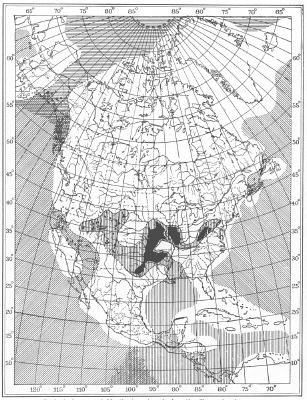 |
|
Explanation of Plate LVI
PENNSYLVANIAN FISHES
A. Coelacanthus exiguus Eastman. Coal Measures shales of Mazon Creek,
near Morris, Illinois. Nearly complete individual, lacking posterior dorsal
and anal fins. X 2/1 After Eastman. Original in Yale Museum.
B. Elonichthys perpennatus Eastman. Pennsylvanian shales of Mazon
Creek, near Morris, Illinois. Complete individual, the distal portion of
medium fins not fully shown. X 2/1 After Eastman. Original in Museum of
Comparative Zoology at Harvard University.
C. A fish brain, possibly one of the Paleoniscidae, from the Coal Measures
shales near Lawrence, Kansas. The original brain was about 18 mm. in length.
The brains are enclosed in small rounded nodules and they occur in
abundance' at two localities in Douglas County, Kansas. Some of the Kentucky
shales also may have these same fossils.
D. A salt water fish from the Pennsylvanian of Illinois; a shark-like animal
known as Edestus crenulatus. The right portion of the dental armature
of a large fish. Original in the U. S. National Museum. After Hay. |
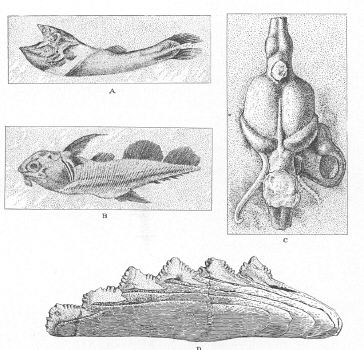 |
|
Explanation of Plate LVII
PENNSYLVANIAN FISHES
A. Acanthodes beecheri Eastman. A tiny shark from the Coal Measures
shales of Mazon Creek, near Morris, Illinois. Restoration showing outline of
body and position of fins. X 2/1. After Eastman.
B. Cheirodus orbicularis Newberry and Worthen. A fairly
well-preserved specimen, from the Pennsylvanian shales of Mazon Creek near
Morris, Illinois. Nat. Size. After Eastman.
C. Elonichthys hypsilepis Hav. A nearly complete specimen from the
Pennsylvanian shales at Mazon Creek., near Morris, Illinois, X 1/3. After
Eastman.
D.-G. Lung fish remains from the Coal Measures of Ohio. After Hussakof.
D. Scale of Sagenodus. Natural size.
E. Tooth of Sagenodus serratus. Natural size.
F. Part of cranium of Ctenodus ohiensis. X 1/2.
G. Rib of Sagenodus. Natural size. |
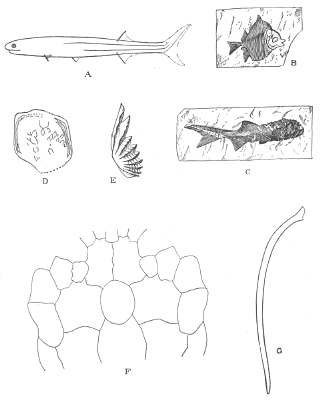 |
|
Explanation of Plate LVIII
A. Type specimen (and the only one known) of Pelion lyelli Wyman,
from the Ohio Coal Measures at Linton. This animal is thought to represent
the ancestral group from which the frogs were derived. Original in the
American Museum of Natural History. length of specimen as preserved 110 mm.
B. Type and only specimen of a true branchiosaur, Micrerpeton caudatum
Moodie, from the Coal Measures of Mazon Creek, near Morris, Illinois,
showing skeletal elements, preserved as kaolin form of head and tail, the
lateral-line sense organs, banded color markings, ventral scutellae, and
small body scales. On the edges of the tail impression are indications that
in life the tail had a thin fold of skin above and below the fleshy portion,
much as in the larvae of modern salamanders. Original in Walker Museum,
University of Chicago. Length of entire animal as preserved 49 mm. |
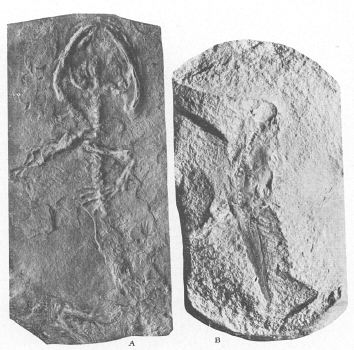 |
|
Explanation of Plate LIX
Upper. Restoration of probable appearance of a small (slightly longer
than five inches) reptile-like amphibian from the Mazon Creek shales of
Illinois and known as Amphibamus grandiceps Cope. The restoration is
based on complete material at the University of Chicago and at Yale
University. Amphibamus was a low, flat, short, creeping or crawling
animal, possibly spending a part of the time in the water.
Lower. A reconstruction of the possible appearance of the small
branchiosaurian Micrerpeton caudatum Moodie from the Mazon Creek
shales of Illinois. The animal was about two inches in length. This figure
is based on a single example now preserved in Walker Museum, University of
Chicago, aided by an examination of other specimens of a related species,
Eumicrerpeton parvum Moodie, the originals of which are preserved in the
Peabody Museum at Yale University. The animal was a small, salamander-like
amphibian frequenting the borders of pools in the marshes of Coal Measures
time. |
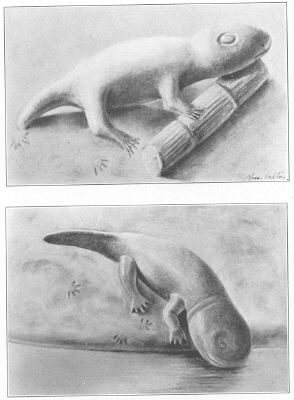 |
|
Explanation of Plate LX
This plate shows the usual type of material on which our knowledge of the
Pennsylvanian amphibians is based. Some of these animals may, originally,
have been represented by fairly complete skeletons, but the accidents of
mining, weathering and collecting account for the loss of much of the
skeleton. Most of the material from the Ohio Coal Measures was collected
from the dump. Some of it was derived from splitting hundreds of tons of
cannel coal, both methods liable to result in loss.
A. A portion of the left mandible of a large amphibian, Macrerpeton deani
Moodie, the largest animal of the Ohio coal. Type specimen, No. 2934,
American Museum of Natural History. Length of specimen, 115 mm.
B. Fore-limb of an amphibian uncertainly identified as Pleuroptyx
clavatus Cope, X 0.75.
C. Interclavicle of Sauropleura pauciradiata Cope from the Ohio Coal
Measures, Nat. Size.
D. Left clavicle of same. Natural size.
E. Part of the body of a snake-like amphibian known as Molgophis
brevicostatus Cope. Linton, Ohio, Coal Measures.
F. A small branchiasaur, Eumicrerpeton parvum Moodie, showing
preservation of alimentary tract. Mazon Creek shales, near Morris, Illinois.
Yale University Museum.
a=anus
in=intestine
l=liver
st=stomach
oes=oesophagus
G. Pelion lyelli Wyman, an amphibian from the Coal Measures of Ohio,
the supposed ancestral salientian (After Wyman) Slightly less than natural
size.
H. I. J. Remains of Eobaphetes kansensis Moodie, from the Coal
Measures of Washington County, Kansas. Originals in U. S. National Museum. |
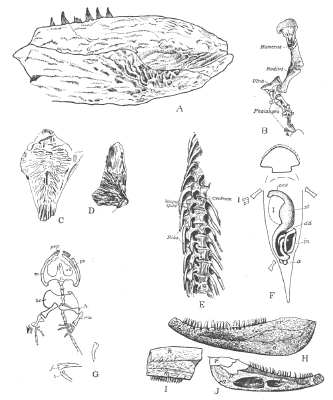 |
|
Explanation of Plate LXI
Much of our knowledge of the Pennsylvanian Tetrapoda is based on very
fragmentary remains or impressions, but in the plate shown herewith are
drawings of our unusually well preserved Coal Measures Amphibians.
A. A Skeleton of Amphibamus grandiceps Cope, Mazon Creek shales, near
Morris, Illinois. About natural size. Original specimen is No. 794, Marsh
Collection, Peabody Museum, Yale University.
B. An amphibian whose body was scaled. Type specimen of Cercariomorphus
parvisquamis Cope, from the cannel coal of the Ohio, Linton, Coal
Measures. The original is in the American Museum of Natural History, Length
of entire specimen is 180 mm.
C. Skeleton of Mazonerpeton longicaudatum Moodie. a Coal Measures
branchiosaur, from the Mazon Creek shales at Morris, Illinois. Specimen No.
795, Yale Museum; length of entire specimen is 64. mm.
D. Skeleton of Cephalerpeton ventriarmatum Moodie. Mazon Creek shales
of Illinois. Natural size. Specimen in Yale University; length of entire
specimen 98 mm. |
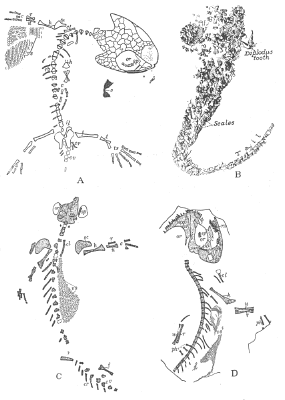 |
|
Explanation of Plate LXII
Footprints of a gigantic amphibian, Wakarusopus (Onychopus)
gigas Martin as they occur in the sandstone ledge of the Upper Coal
Measures, just above the Weston shales. Wakarusa Creek at Dightman's
crossing, Douglas County, Kansas. |
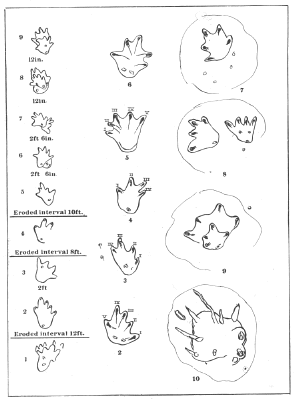 |
|
Explanation of Plate LXIII
Reconstruction of the probable appearance of one of the large
labyrinthodonts which lived at the close of the Pennsylvanian period and on
through the Permian and Triassic. Several discoveries in North America, in
rocks of undoubted Pennsylvanian age, indicate that these large,
reptile-like amphibians, from six to fifteen feet in length, existed in the
borders of swamps with their smaller relatives. The skeletal material, on
which this supposition is based, is scanty, consisting of parts of ribs,
vertebrae, skulls and jaws of the genera: Baphetes, Eobaphetes, Eosaurus,
Macrerpeton, Eryops and others.
Adapted from Fraas. |
 |
|
Explanation of Plate LXIV
Type and only specimen of the "oldest known reptile" Cannel coal at
Linton, Ohio; known as Eosauravus copei Williston. The Original is in
the United States National Museum. No. 457. The fossil animal as it is
preserved measures 132 mm in length. |
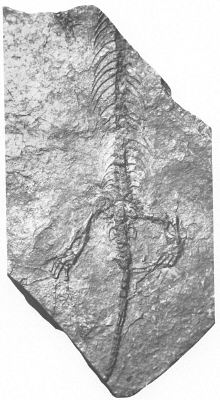 |









